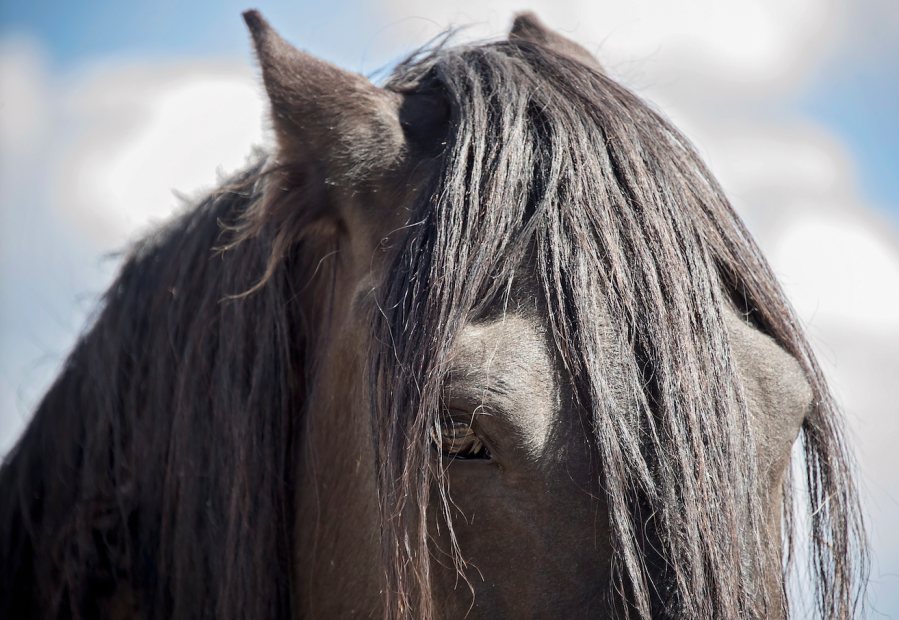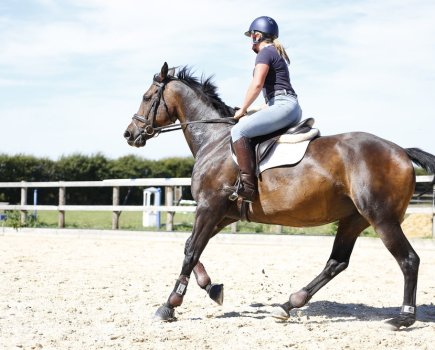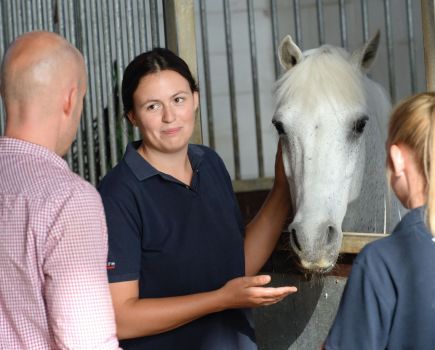Many horse owners have a love or hate mentality when it comes to female equines. I’m firmly in the ‘love’ camp. I’ve owned three mares and feel my best partnerships have been with them compared to geldings.
With an estimated 300,000 mares in the UK* and 93%** of mares in general showing undesirable ‘moody’ behaviour when in season, it’s easy to see why owning a mare can prove to be challenging to say the least.
Normal life for a mare in the wild is very different compared to our domesticated mares, but they have one thing in common: the biological intention is for her to become a parent.
Most of us won’t breed from our mare, so this means she doesn’t get that natural outlet for her hormonally-driven reproductive behaviour. This is why frustration and changes in behaviour are likely every 21 days, leading to a mare in season.
Understanding the oestrus cycle
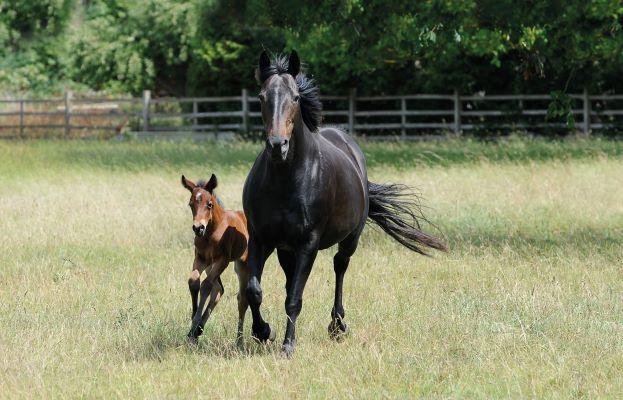
The biological intent of every mare is to bear a foal
- A mare reaches sexual maturity at 18 months old and will continue to cycle throughout her lifetime.
- As spring arrives and daylight hours increase, mares will start their oestrus cycle again and have regular cycles throughout the summer months.
- During the winter, when a mare isn’t normally in season, they are said to be in anoestrus.
- The normal oestrus cycle lasts for 21/22 days and during this time she will have four to seven days when she is most receptive to a stallion for breeding, with ovulation usually occurring on about day five of the cycle.
- If the egg is not fertilised, the mare will move into the dioestrus phase, which lasts for between 13 and 17 days. This is when the hormone progesterone is dominant and then her cycle starts again and you have a mare in season.
Changing behaviour
It’s the changes in behaviour of a mare in season that gives them a bad name and for some people makes them undesirable to own or ride.
However, it’s important to remember that a ‘moody mare’ is merely exhibiting natural behaviours. She’s not behaving badly or wilfully — it’s almost beyond her control.
So rather than referring to them as ‘bad behaviours’, changing the terminology we use to ‘undesirable behaviour’ is better.
Essentially, it’s the different hormones that cause a change in behaviour of a mare in season, as she switches from progesterone being the dominant hormone to oestrogen being dominant.
Breaking down the common ‘moody mare’ behaviours we see into two categories is useful:
1 Mare-specific behaviour
These are behaviours that are only really displayed by a mare in season, such as:
- Winking
- Squirting
- Raising her tail
- Squealing
- Frequent urination
- Repetitive vocalisation
2 Non mare-specific behaviour
This is any aggressive type of behaviour earning the tag ‘moody mare’, such as biting, kicking, bucking and grumpiness, as well as difficulty tacking up, lack of concentration, poor performance and stereotypical behaviours such as weaving.
While a mare in season may show these behaviours, these are classed as non mare-specific as they could be displayed by any horse that has other underlying conditions and could be pain related.
Sometimes there is a genuine physical abnormality that explains the behaviour of a ‘moody mare’ and if you are concerned you should seek your vet’s advice.
Moody mares: undesirable behaviour
Undesirable behaviour by a mare in season can cause significant problems for owners, having an impact on your safety and the safety of other horses.
Sometimes a ‘moody’ mare can even cause damage to herself. How this behaviour is dealt with can have further implications. For example, you may find that during her season it disrupts the usual yard routine as you find yourself trying to avoid contact with other horse owners or vice versa.
It can also end up with a ‘moody’ mare being turned out on their own to avoid any possible injury to other horses or to themselves exacerbating the problem further.
A drop in performance when competing can be common too — a mare in season who is showing undesirable behaviour is unlikely to be able to perform to the best of her ability.
Having a better understanding of the behaviour of wild horses will help us improve our knowledge and handling of domesticated mares as Jenni Nellist, clinical animal behaviourist, explains.
“When a mare isn’t in season, she will usually reject any sexual approach from the stallion. This is done mostly by walking away and often they are happy to mutually groom with him. Once she starts to come in to season, she’ll feel more conflicted — not quite ready for courtship but she’s attracting more attention from the stallion and her behaviour reflects this.
“On the one hand, she may welcome his approach but then very quickly change her mind and can quite forcefully reject his advances,” continues Jenny.
“Feeling irritable is typical of mares approaching the most receptive time of her cycle because they are conflicted between seeking and avoiding that courtship.”
Why it’s an owner’s job to be considerate
It’s during this phase that we need to think about what we expect a mare in season to tolerate from us and why during her oestrus cycle she may display a change in behaviour. For example, we brush her on a daily basis.
Being irritable and not wanting to be touched is one of the behaviours commonly seen, yet we still expect her to let us brush her and deem her a ‘moody mare’.
We also ride a mare in season and compete in the company of both familiar and unfamiliar horses, and there are times during her cycle when she will find this difficult.
When you stop to think about how she may be feeling, you can’t help but think we’re looking for trouble. Mostly this behaviour is natural, if somewhat frustrating for the owner and also more importantly, for the horse, when at times her lifestyle makes her seasons feel more challenging to her.
She isn’t just being a moody mare!
How to meet a ‘moody’ mare’s needs
As with any horse, it’s important that all of their needs are met and this is especially true of a mare in season.
The following represents the five domains model of animal welfare by Professor David Mellor:
- Correct nutrition — fibre-based and for a mare’s individual requirements.
- Environment — a suitable place to live in, with places to shelter, dry places to rest and space to move about.
- Prevention and or treatment of injury or disease — if you’re not sure, chat to your vet about any concerns you have for your ‘moody mare’.
- Natural behaviour — this is the ability to fulfil natural behavioural drives. These include having good foraging opportunities, being able to move freely and choose whether to play or rest. Competent handling and training that supports and teaches, and doesn’t hurt, frighten or confuse, is also important, as is good equine company — other horses that the mare gets on with.
- Mental domain — life wants to be mainly good and then she can deal with the stuff that’s not so good. We need to think that welfare is a state that’s experienced by mares. What is correct for an individual mare over the first four domains does depend on her natural adaptations as a horse and individual characteristics, and her own life experiences.
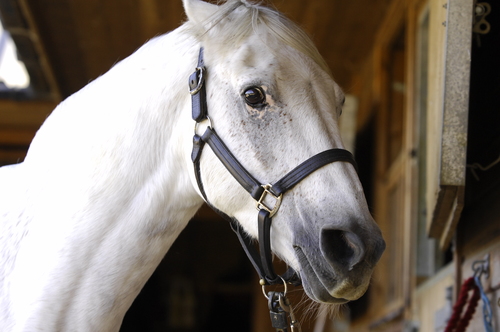
Be sympathetic to how a ‘moody mare’ is feeling — there’s a lot going on in her body
How to meet a moody mare’s needs
How all of these needs are met affects whether your mare is having a good experience or a bad one.
Each of the first four domains generate your horse’s daily life experiences.
When those experiences are mostly positive and the negative ones can be controlled and are short-lived, life can be said to be good.
Your mare’s experience over these four domains feeds into the fifth one: the mental domain that forms her welfare state.
How to help a mare in season
You can meet your mare’s needs, and learn to adapt to how she’s feeling and accept that some mares are just more sensitive due to their genetic inheritance. Clinical animal behaviourist Jenni Nellist suggest the following eight things to think about when your mare is in season:
- Groups of two to four horses work well, especially where space is limited.
- Some ‘moody mares’ are happier turned out with geldings rather than other mares.
- In a big herd, you need enough land for the horses to form splinter groups. This might be a series of fields where you have around three acres per horse and the gates are left open so they are able to roam.
- Stables force horses to stand in close proximity. When they can’t see one another, they become stressed by isolation, so when they can see each other it’s best that they like their neighbour. Switch things around if you can in order to find a compatible horse for your mare to live next door to.
- Consider her nutrition. Horses are selective grazers, and at their healthiest when they have access to multiple different forages. The right selection will support the gut and hormone regulation for optimal gut/brain function, easing the effects of other stressors. Supplementation and access to forage that suits her needs is likely to make for a less moody mare.
- Find out where she likes to be touched. Most like a good wither scratch, but if she’s feeling really touchy that might not be acceptable. Read her mood and stop if she tells you.
- Find out what grooming tools she likes and only use those when the mare is in season.
- Use licks or a haynet to distract her when you need to do essential hands-on activities like grooming.
Why more sympathy builds a stronger partnership
I adjusted my mare Wish’s training schedule when I noticed that a dip in her performance coincided with her being in season. I have owned her since she was three.
The first summer I owned Wish, our training and competing was going well, but every so often she wasn’t quite so willing.
My trainer at the time suggested that I keep a diary of her behaviour as he thought it could be her seasons causing this. She wasn’t being a moody mare, just lethargic and a bit tight in her back.
By keeping a diary it soon became obvious that it coincided with when she was in season.
Once I knew this, I adjusted Wish’s training so those few days when she wasn’t herself were either rest days or hacking days. I would try and avoid competing too, as there was a clear drop in her dressage scores.
As she has got older this behaviour has disappeared, but I feel that being more sympathetic to how she was feeling and giving her a few easy days has very much helped to build a really strong partnership.
As a woman myself, I kind of understand how she is feeling!
Images: copyright Shutterstock
References: *British Equestrian Trade Association’s National Equestrian Survey 2019 **1.Mills, D and Nankervis, K. 1999. Equine Behaviour: Principles & Practice. Blackwell Science Ltd. (p144) 2.Waring, G.H. 1983. Horse Behaviour: The behavioural traits and adaptations of domestic and wild horses, including ponies. Noyes Publications, Park Ridge, New Jersey

